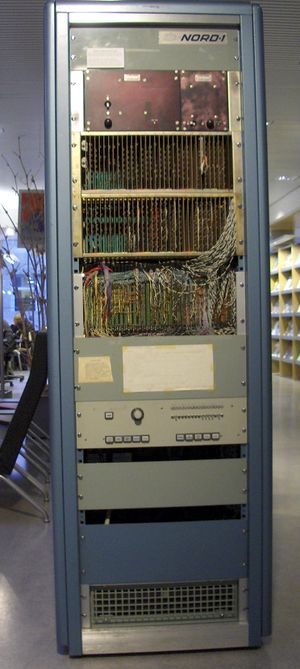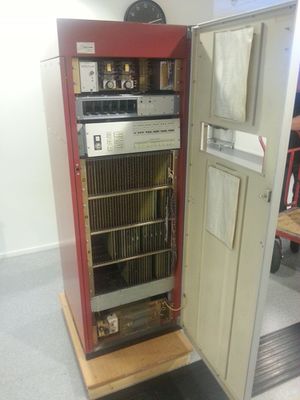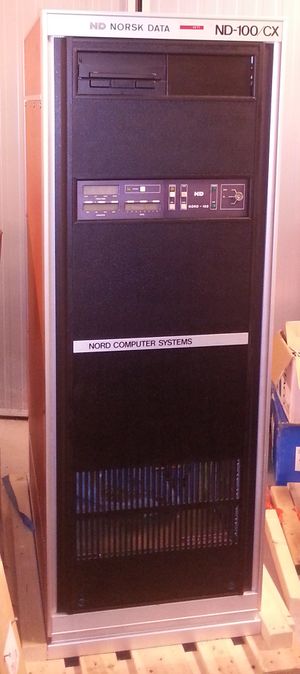Cabinet: Difference between revisions
(Initial page, just collecting my thoughts.) |
(Added some pictures) |
||
| Line 7: | Line 7: | ||
== NORD 1 == | == NORD 1 == | ||
[[Image:ND NORD-1.TS.jpg|thumb|An early NORD-1]] | |||
[[Image:Nord-1 snr-47 Door open.jpg |300px | thumb | NORD-1 snr 47 ]] | |||
Several images of early [[NORD-1]] systems shows that there were a number of different cabinet and colors made. At the end of the production the cabinet used closely resembled the cabinet used in NORD-10/S | Several images of early [[NORD-1]] systems shows that there were a number of different cabinet and colors made. At the end of the production the cabinet used closely resembled the cabinet used in NORD-10/S | ||
| Line 15: | Line 17: | ||
== NORD-10 == | == NORD-10 == | ||
<br clear=all> | |||
== NORD-10/S and NORD-50 == | == NORD-10/S and NORD-50 == | ||
[[Image:NORD-10_Naked_cabinet.jpg |300px | thumb | An empty NORD-10 cabinet.]] | |||
[[Image:NORD-50_Cabinet.jpg |300px | thumb | NORD-50 cabinet.]] | |||
At this time the cabinet size was fixed. The [[NORD-10]] came in a bright orange colored cabinet with side panels just popped on. This made it very easy to access the CPU rack and other parts. To accommodate power wiring and other things not in 19" modular form there were iron profiles that could be cut at length and just bolted together. | At this time the cabinet size was fixed. The [[NORD-10]] came in a bright orange colored cabinet with side panels just popped on. This made it very easy to access the CPU rack and other parts. To accommodate power wiring and other things not in 19" modular form there were iron profiles that could be cut at length and just bolted together. | ||
| Line 24: | Line 29: | ||
== NORD-42 == | == NORD-42 == | ||
<br clear=all> | |||
== ND-100 == | == ND-100 == | ||
[[Image:ND-100_Small_cabinet.jpg |300px | thumb | The small ND-100 cabinet.]] | |||
[[Image:ND-100_Large_cabinet.jpg |300px | thumb | The large ND-100 cabinet.]] | |||
The [[ND-100]] first came in a small and a large cabinet. The size of the cabinet were deeper than the NORD-10 form factor. This made it possible to use the same cabinet for both CPU:s and the now shrinking hard disk drives and tape drives. | The [[ND-100]] first came in a small and a large cabinet. The size of the cabinet were deeper than the NORD-10 form factor. This made it possible to use the same cabinet for both CPU:s and the now shrinking hard disk drives and tape drives. | ||
| Line 31: | Line 39: | ||
Later machines shrank down even more, giving rise to the [[Satellite]] and [[Compact]] series of computers. These are not hosted in a cabinet though. | Later machines shrank down even more, giving rise to the [[Satellite]] and [[Compact]] series of computers. These are not hosted in a cabinet though. | ||
<br clear=all> | |||
== ND-500 / ND-100 == | == ND-500 / ND-100 == | ||
[[Image:ND-500_Cabinet.jpg |300px | thumb | The ND-500 cabinet.]] | |||
When the [[ND-500]] CPU arrived it also came in a 19" crate, slightly bigger than the ND-100 crate. The first machines used the same large cabinet as the ND-100. | When the [[ND-500]] CPU arrived it also came in a 19" crate, slightly bigger than the ND-100 crate. The first machines used the same large cabinet as the ND-100. | ||
<br clear=all> | |||
== ND-500/2 / ND-110 == | == ND-500/2 / ND-110 == | ||
The second generation of ND-500 family of computers, the [[ND-500/2]] seems to have arrived at the same time as a new tan to brown cabinet. This cabinet was used for the rest of the lifetime of the company. With the ND-100 in the front and the ND-500/2 at the rear it was a very compact machine. | The second generation of ND-500 family of computers, the [[ND-500/2]] seems to have arrived at the same time as a new tan to brown cabinet. This cabinet was used for the rest of the lifetime of the company. With the ND-100 in the front and the ND-500/2 at the rear it was a very compact machine. | ||
| Line 40: | Line 51: | ||
== ND-5000 / ND-120 == | == ND-5000 / ND-120 == | ||
The crates were rearranged from the time of ND-500/2, bringing the [[ND-5000]] CPU rack to the front. Both crates could now be accessed from the front and a new power distribution system with bus bars running along the side of the machine. The old system with flat cables | [[Image:ND-5000_Cabinet_rear.jpg |300px | thumb | Rear view of an empty ND-5000 cabinet.]] | ||
The crates were rearranged from the time of ND-500/2, bringing the [[ND-5000]] CPU rack to the front. Both crates could now be accessed from the front and a new power distribution system with bus bars running along the side of the machine. The old system with flat cables to the I/O connectors were replaced with a card crate, hosting connector cards with the connectors already mounted. This is a very modular design and it meant that the I/O area could easily be reconfigured in no time. | |||
The top crate at the rear have place for three modular power supplies. | |||
== References == | == References == | ||
[[Category:Norsk Data hardware]] | [[Category:Norsk Data hardware]] | ||
Latest revision as of 22:56, 30 September 2018
|
|
This article is a stub. You can improve NDWiki by expanding it. |
Most of Norsk Data computer systems are based on a 19" cabinet standard. The larger machines were all hosted in a 19" cabinet of some sort. Over the time the cabinets changed style.
Personal note : As I wasn't there this article is based on personal observations of remaining machines and surviving documentation. I might have introduced severe errors in this article, especially on the early years. Please, either correct the article or contact me if you spot an error.
Gandalf (talk) 13:42, 30 September 2018 (UTC)
NORD 1
Several images of early NORD-1 systems shows that there were a number of different cabinet and colors made. At the end of the production the cabinet used closely resembled the cabinet used in NORD-10/S
NORD 2B
NORD 4
NORD-10
NORD-10/S and NORD-50
At this time the cabinet size was fixed. The NORD-10 came in a bright orange colored cabinet with side panels just popped on. This made it very easy to access the CPU rack and other parts. To accommodate power wiring and other things not in 19" modular form there were iron profiles that could be cut at length and just bolted together.
NORD-12
NORD-20
NORD-42
ND-100
The ND-100 first came in a small and a large cabinet. The size of the cabinet were deeper than the NORD-10 form factor. This made it possible to use the same cabinet for both CPU:s and the now shrinking hard disk drives and tape drives.
The small cabinet could take a 12 position ND-100 crate while the large cabinet could take the 23 position ND-100 crate
Later machines shrank down even more, giving rise to the Satellite and Compact series of computers. These are not hosted in a cabinet though.
ND-500 / ND-100
When the ND-500 CPU arrived it also came in a 19" crate, slightly bigger than the ND-100 crate. The first machines used the same large cabinet as the ND-100.
ND-500/2 / ND-110
The second generation of ND-500 family of computers, the ND-500/2 seems to have arrived at the same time as a new tan to brown cabinet. This cabinet was used for the rest of the lifetime of the company. With the ND-100 in the front and the ND-500/2 at the rear it was a very compact machine.
There are wheels on this cabinet so it is easy to move around or just pulled out for service. The side panels are fastened with twist lock fastener while the plastic front panel was held on place with two star screws accessible from the top of the cabinet.
ND-5000 / ND-120
The crates were rearranged from the time of ND-500/2, bringing the ND-5000 CPU rack to the front. Both crates could now be accessed from the front and a new power distribution system with bus bars running along the side of the machine. The old system with flat cables to the I/O connectors were replaced with a card crate, hosting connector cards with the connectors already mounted. This is a very modular design and it meant that the I/O area could easily be reconfigured in no time.
The top crate at the rear have place for three modular power supplies.







